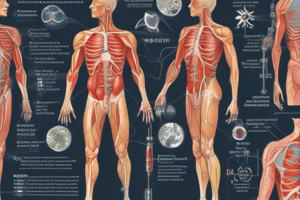Podcast
Questions and Answers
Which of the following is an example of a volatile acid?
Which of the following is an example of a volatile acid?
- H3PO4
- CO2 (correct)
- acetoacetic acid
- H2SO4
Which defense mechanism is composed of a weak acid and its salt?
Which defense mechanism is composed of a weak acid and its salt?
- Protein buffer
- Buffer system (correct)
- Respiratory mechanism
- Renal mechanism
What is the most abundant inorganic acid mentioned in the text?
What is the most abundant inorganic acid mentioned in the text?
- H3PO4
- H2SO4 (correct)
- lactic acid
- acetoacetic acid
Which mechanism is responsible for excreting excess acids or bases from the body?
Which mechanism is responsible for excreting excess acids or bases from the body?
What is the function of carbonic anhydrase in the body?
What is the function of carbonic anhydrase in the body?
Which of the following is an example of a fixed, nonvolatile acid?
Which of the following is an example of a fixed, nonvolatile acid?
Which defense mechanism acts rapidly and is composed of a weak acid and its salt?
Which defense mechanism acts rapidly and is composed of a weak acid and its salt?
What is the main function of carbonic anhydrase in the body?
What is the main function of carbonic anhydrase in the body?
Which mechanism is responsible for maintaining acid-base equilibrium in the body?
Which mechanism is responsible for maintaining acid-base equilibrium in the body?
What are the two components of the bicarbonate buffer system?
What are the two components of the bicarbonate buffer system?
Flashcards are hidden until you start studying
Study Notes
Acid-Base Concepts
- Volatile Acid: Carbonic acid (H₂CO₃) is an example, formed from carbon dioxide and water in the body.
- Defense Mechanism with Weak Acid and Salt: The bicarbonate buffer system consists of carbonic acid (weak acid) and bicarbonate (salt).
- Abundant Inorganic Acid: Sulfuric acid (H₂SO₄) is highlighted as the most abundant inorganic acid in biological systems.
- Excretion Mechanism: The renal system plays a key role in excreting excess acids or bases, maintaining overall acid-base balance.
Functions of Carbonic Anhydrase
- Carbonic Anhydrase Role: Catalyzes the conversion of carbon dioxide and water into carbonic acid, facilitating gas exchange and pH regulation.
- Main Function: Enhances the efficiency of carbon dioxide transport and regulates bicarbonate levels in the blood.
Additional Acid-Base Mechanisms
- Fixed, Nonvolatile Acid Example: Phosphoric acid (H₃PO₄) serves as an example of a fixed, nonvolatile acid produced from metabolism.
- Rapid Defense Mechanism: The bicarbonate buffer system acts quickly to maintain pH levels, essential for physiological stability.
Bicarbonate Buffer System Components
- Bicarbonate Buffer System Components: Composed of carbonic acid (H₂CO₃) and bicarbonate (HCO₃⁻), which work together to stabilize pH in the body.
- Acid-Base Equilibrium Mechanism: Both the respiratory and renal systems collaborate to maintain acid-base equilibrium through excretion and reabsorption processes.
Studying That Suits You
Use AI to generate personalized quizzes and flashcards to suit your learning preferences.





